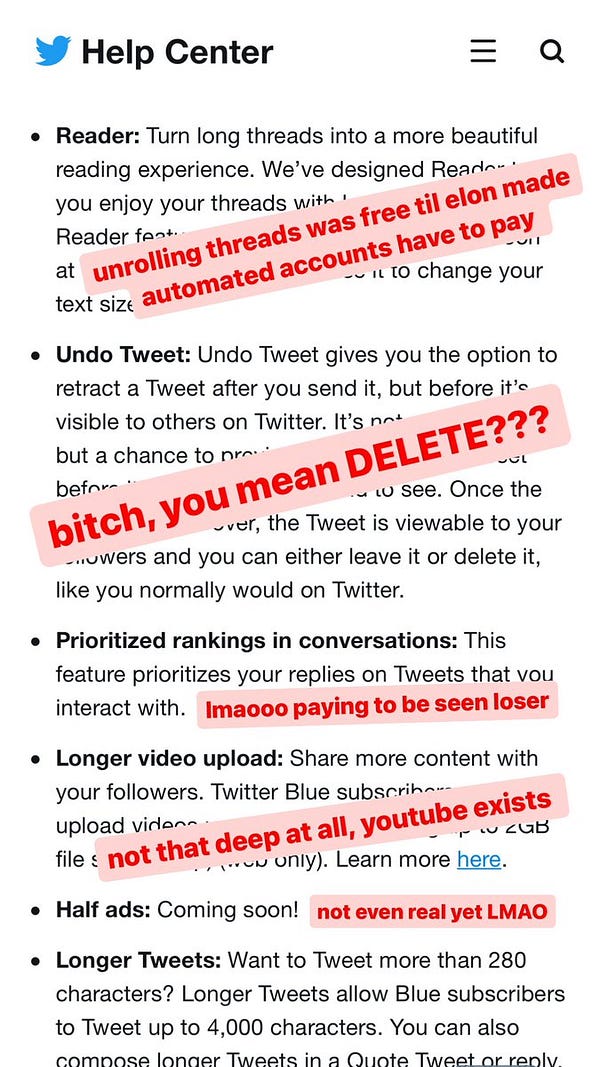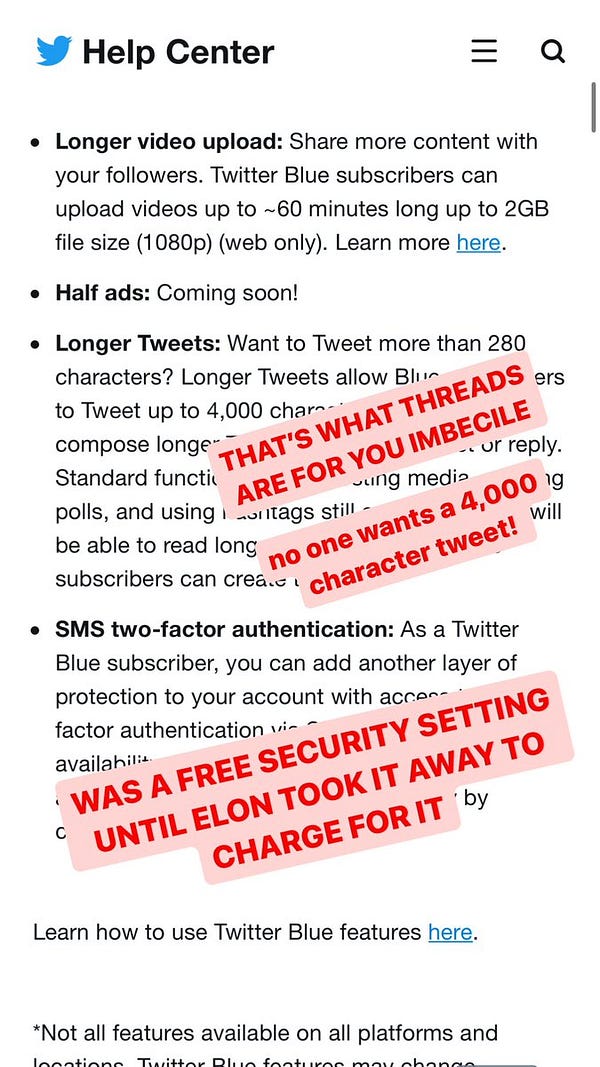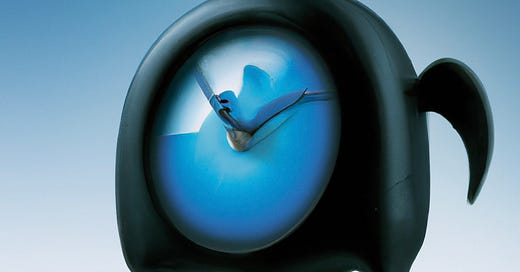Last spring, CNN rolled out its new CNN+ digital service to generally tepid reviews and jokes about whether its shows — like one that featured Anderson Cooper’s parenting advice — were real or just some fevered concoction from executives smashing ideas together.
“CNN+ in its formative phase feels somewhat like the Quibi1 of streaming news,” Josef Adalian wrote for Vulture. “It’s hard to figure out just what the service is supposed to be and why a large number of people will want to pay for it.”
For me, this was catnip: I had to sign up for CNN+. (To be fair, I was also one of the people who signed up for Quibi a year earlier.)
As a rule, I like to sample books, podcasts and other products that are being widely dismissed. At worst, I lose a little time or money, but get to judge the merits for myself. At best, I’ve found ideas and scoops that are being overlooked.2
So that’s one reason I decided to try Twitter Blue, the premium version of the social-media site. The paid service has been treated as a joke among my Twitter buddies and in most articles I saw — as a form of hostage-taking by Elon Musk, who promised features that nobody really wanted and coveted blue checkmarks on demand, if you only paid his company $11 per month.





Was Twitter Blue as bad as everyone said it was? I wanted to know.
There were two other temptations, too.
I was curious about Musk’s promise that Twitter Blue users would get their posts elevated. I don’t believe there’s any glory in writing articles that no one sees; part of the reason that reporters should use Twitter is to amplify their work.3
I’ve adored Twitter for more than a decade … but hate using its clunky native app. Instead, I relied on a third-party app called Tweetbot, which filtered out some of Twitter’s worst elements. Then Musk cut off Tweetbot users in January, effectively forcing me and others back to Twitter’s native app. Could Twitter Blue improve the user experience? I wasn’t sure, but wanted to find out.
Of course, when I signed up for Twitter Blue, I thought it would be a private trial with no real consequences. But Musk announced last week that Twitter would finally do away with checkmarks for journalists and others who had been “verified” as notable accounts, starting April 1. In response, many media organizations — the Washington Post included — confirmed that they wouldn’t pay for checkmarks-on-demand.

This leaves me in the odd and awkward position of being a rare Post reporter who may soon still have a blue “verified” check, even as my friends and colleagues lose theirs. For years, media members clamored for those checkmarks as a sign of respectability; it doesn’t take psychic powers to see that they may quickly become an object of mockery.
And I’m only partway through my subscription period; even if I canceled today, I’ll still have Twitter Blue and its visible scarlet letter sapphire checkmark through at least April 9.
Oh well! Consigned to my fate as a possible pariah, let’s move on.
So: Is it worth it?
There are a few Twitter Blue perks that I definitely enjoy.
— You can customize the app’s layout. Just like with an iPhone home screen, you can move around the menu icons and swap out ones you don’t use.
For instance, I got rid of the “Spaces” button on the Twitter toolbar, since I usually only clicked on that by accident, and replaced it with a button called “Top Articles,” which I click on with gusto.
Speaking of “Top Articles”…
— Top Articles. This is my favorite feature of Twitter Blue, by far. That’s not surprising; Top Articles used to be a much-loved app called Nuzzel before Twitter acquired it and made it a perk of Twitter Blue.
So what’s Top Articles? It shows you the most popular articles and content among the people you follow and the people they follow.


If you follow hundreds or thousands of people on Twitter, like I do, it’s a terrific way of surfacing articles to read. That’s especially true during a busy news cycle when, say, the former president is indicted and it feels like many stories are getting drowned out. It’s professionally useful to know that specific people are talking about certain articles, too.
— Undo tweet. After hitting “send” on a tweet, Twitter Blue users can get a brief window to review the post one last time before it goes public.
This 30-second delay screen routinely helps me realize I’ve made a mistake, ranging from minor typos to possible gaffes in my phrasing. (This is no small thing as a Post reporter; anyone can delete a tweet, but posting a bad one can haunt you. I’ve seen how inartful tweets can be quickly screen-shotted and thrown back at the author for months.) And even when I don't mess up, the 30-second delay often lets me think of a better tweet4 than the one I originally wrote.
As a result, I probably click the “undo” button and redo a quarter of my tweets since joining Twitter Blue.
— Smoother interface. Twitter Blue makes it easier to quickly scan multi-tweet threads, with a button that lets you see all of the threaded tweets on one screen. It lets you create folders to organize tweets you bookmark, which I find useful. (I have one bookmark folder called ChatGPT, for instance, to flag all the scary AI tweets that catch my eye.)
— Posting longer videos. This is still theoretical for me; I haven’t tried it yet. But while normal Twitter users are limited to posting videos that are 140 seconds or less, Twitter Blue users can post videos that are up to 1 hour long. That’s appealing because there have been many times over the years where I wanted to post, say, a 300-second exchange between a senator and a health expert, but was forced by Twitter’s limits to sacrifice some context and chop up those videos.
What isn’t valuable to me about Twitter Blue
One selling point of Twitter Blue is that its users can post really, really, really long tweets. No longer are you limited to 280 characters; this recent Twitter Blue tweet was 3,937.
Some of these deep-dive posts can be useful. But Twitter’s unique value, to me, has always been its pithiness. The initial 140-character and current 280-character limit forced users to be concise and inventive. It made the site a fast, addictive read. The more that’s diluted, the more Twitter becomes like so many other services.
And if you want to regularly write 4,000-character manifestos, there are plenty of options — Substack being one of them.
Twitter Blue also offers lots of cosmetic tweaks that don’t matter to me, like changing the color of your app or the icon’s design on your device.
And until recently, Twitter Blue’s promise of a “verified” checkmark was moot, given that I’ve had a verified checkmark for years.
It’s also not clear to me that Twitter Blue is giving my posts any sort of bump; the “impressions” on my tweets in March were down about 30 percent compared to last year, although I suppose there are all kinds of confounding variables, including that I was on paternity leave and writing fewer articles to tweet about.
What doesn’t sit right for me
Most vexing, Twitter Blue is bound up in the general decline of the site during the Musk era.
It’s one thing to sample Twitter Blue; it’s quite another to feel pressured into it, with the implication that many or most users won’t see your tweets if you don’t pay $11 a month.
I loved the intellectual meritocracy promised by early Twitter — if you wrote a particularly useful or clever tweet, it could catch fire, and all manner of people would discover it. Twitter Blue, with its walled gardens, feels like the opposite of that.
The push to change “verification” from “a trusted news source or public figure” to “anyone willing to pay” also unsettles me.
As my colleagues Rachel Lerman and Faiz Siddiqui wrote at The Post:
The change expected Saturday could fundamentally change how Twitter is used and how it is trusted, users and experts say. If the fears are borne out, it will no longer be possible to quickly ascertain whether a public figure’s account is legitimately associated with that person, or the potential work of a sly impersonator.
The verdict
Taken together, I do value a bunch of Twitter Blue’s features. And if some unproblematic third-party company — say, a hypothetical firm called Nuzzel or Tweetbot — unveiled an app that offered Top Articles and a better Twitter user interface for a small fee, like $5 upfront, I bet there would be evangelists for it.
And more broadly, I’m hooked on Twitter, which has given me so much personal joy and professional help for years. I already pay to subscribe to dozens of publications, Substacks and podcasts — what’s a few dollars more, if that’s the cost to help subsidize a valuable media service?
But we don’t live in a world where there’s some unproblematic company selling Twitter Blue features. And Twitter isn’t public radio or a struggling news outlet; it’s not clear to me that the company needs my $11/month to survive.
And one big difference from trying out CNN+, or Quibi, or any other product I privately sampled in years past: being seen with Twitter Blue right now has all the social cachet of Austin Powers being caught with his own product promising personal enhancement.
Paying for checkmarks — this sort of thing isn’t my bag! It’s embarrassing!
I can see a path to sticking with Twitter Blue, especially if Musk backs off his plan to try to force reporters, public figures and others to buy the product. It wouldn’t be the first time he’s backed away from his proclamations to change how users are treated, and it would reduce the social stigma of using Twitter Blue for reporters like me.
Alternately, if Musk does push forward with his plans, it’s possible that users’ calculations will change. Will lots of media organizations and reporters decide that Twitter Blue is a worthy investment after all, if engagement on their tweets plunges overnight? The odds seem slim, but one reason I haven’t canceled Twitter Blue yet is that I want to see what happens in the next week.
But if this really is the moment when Twitter is separated into “Twitter Blue” and “everyone else,” I think I’m going to end up with everyone else. Spending $11 a month to enjoy mild benefits in exchange for some public embarrassment isn’t a great trade. As much as I love Top Articles.
Quibi was the much-mocked short-form content platform that quickly collapsed in 2020.
My experience with CNN+ only lasted a week or so; the service was almost immediately shut down. But I got to poke around the app, watch a few shows and sample the idea of a newsroom on demand. I can’t speak for the executives who spent $300 million on it, but for my pocketbook, it felt like a few dollars and hours well spent.
Like many reporters, I’ve bled thousands of followers over the past year, probably because some users have quit the service. In terms of reaching readers, Twitter is currently less valuable to me than when Musk bought it.
At least in my mind; “better” is in the eye of the beholder.





